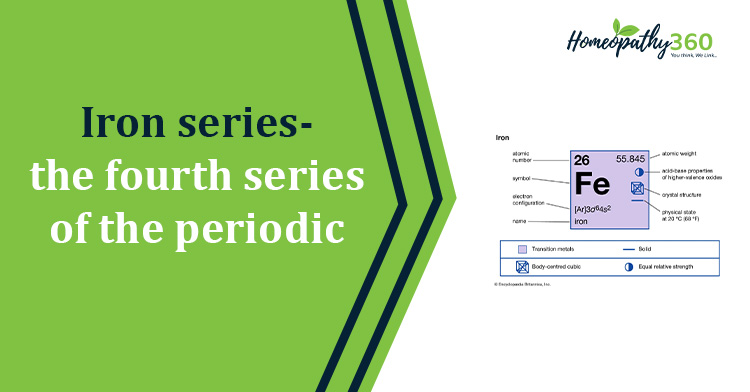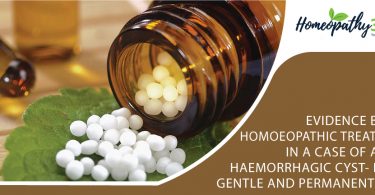
Abstract- Jan Scholten has a great contribution in knowing the elements of the periodic table, which are there in the homeopathic system. He said that every element of each series of the periodic table shows the same characters. Each series is divided into maximum 18 steps and each is illustrated according to their homoeopathic property. The iron series are a group of 18 elements which, along with their salts, have come to be used as homeopathic remedies over the past decades. Row-4 elements are Potassium, Calcium, Scandium metallicum, Titanium metallicum, Vanadium metallicum, Chromium metallicum, Manganum metallicum, Ferrum metallicum, Cobaltum metallicum, Niccolum metallicum, Cuprum metallicum, Zincum metallicum, Gallium metallicum, Germanium metallicum, Arsenicum metallicum, Selenium metallicum, Bromium, Krypton.
Keywords- row 4, aggression, attack, elements, performance, protection, series.
Introduction- Homoeopathy is a system of medicine with more than 20 decades; it is the most harmless system of healing worldwide. The elements of the periodic table have been used since the beginning, but still the main source of homeopathic medicine considers plants only. The concept of major source is plant kingdom has been changed by the contribution of Jane Scholten, who helps us to understand the homeopathic properties of the elements and their salts that result from their combination [1]. Iron series elements as well as their combined salts are used more and more in medical and science field. The Russian chemist, Dmitry Mendeleev, created an outline in the year 1869, for placing the elements, what is now known as the modern periodic table. Elements are placed in the periodic table according to their atomic numbers, chemical and physical properties.In the periodic table, the parallel lines are called periods, in which the metals are attached to the left and the nonmetals are attached to the right. The atomic structure of the elements and the similarity and dissimilarity between them is known only by the periodic table. Mendeleev periodic law stated that “the physical and chemical properties of elements are a periodic function of their atomic weights” [2]. Its homeopathic explanation dates back to the nineties when Sholton identified elements of the periodic table, certain stages and sequences of human development. Each element of the periodic table lies at the convergence of a row and a column; these two coordinates define not only the position of the element but also its properties. To get knowledge about any element of the periodic table, we need to know its row and period, from which we can acquire its characteristics. Scholten said that, every elements show similar characteristic in every (series) of the periodic table. The rows of the periodic table can be viewed as replicating a person’s development, starting from fetal life and ending in the death [3]. Since we view the individual as mineral, we can reach the stage of development in which he is trapped, and identify the next line. Common theme about Iron series is related to the action of personal achievement, this achievement can also go under the guise of ‘performance’. Ferrum is the series key metal and the action of performance are the dual notions of protection and defence [4]. In fact the iron series is related with three principle themes- action, attack and defence. Looking at the metals on the extreme left of the series, one can find Kalium and Calcium both buried in fear requiring defence and protection. But on the right, Bromium’s response to aggression is to counter attack. Metals like Manganum, Ferrum, Cobaltum, Niccolum, Cuprum and Zincum are positioned centrally, where defence is very much present. Recurring themes emerge around protection: police, soldiers, the armed forces. Arsenicum a little further right, is frightened of robbers, against which protection is necessary [5]. Minerals are non-living substances, markedly different from plants and animals, as reflected by the symptoms and issues in their healing drawings. Minerals are distant more organized than creatures and plants; the issues of minerals are as a rule structure, organisation, and security, particular relationship, fund or execution. Minerals are slower, more measured and settled, than those of plants and animals. People who require mineral treatment wear plain clothes, or stripes, checks and symmetrical or geometric designs. Color is not that important to them. The two keywords of the mineral kingdom are structure and function; they are incomplete without function and structure [6]. Scholten introduced the concept of periodic table themes [7]; Sankaran deepens it further by adopting this new approach to the method of sensation [8]. Many ferrum series elements play a role in controlling protein function as secondary messengers, structural components, or enzyme cofactors. Potassium is used by cells to maintain a membrane potential for neurotransmitters. Calcium is a signaling molecule which helps in skeletal muscle contraction in vertebrates. Selenium is a component of amino acid, Manganese enzymes play a role in the virulence of some pathogenic bacteria [9].
Elements of row 4-
Figure- 1[10]
Periodic table with atomic number, symbol, and atomic weight
- Potassium- These patients are extremely conscientious, and extremely “do what has to be done”. They suffer from purulent rhinitis and asthma, aggravated at 3’o clock in the morning [5].
- Calcium- These patients are unsure of what they do, and have multiple fears. Aggravated at 3’o clock in the afternoon. They want to eat eggs and fruits that are difficult to digest.
- Scandium metallicum- These patients are perfectionists who cannot make decisions in matter of choice. They suffer from problems of perspiration and oto rhino laryngology (ulcers in mouth).
- Titanium metallicum- These patients are unable to take the first step. They wake; anxious at 7 o’ clock in the morning, suffer from hemiopia, eczema and have a great desire of apples.
- Vanadium metallicum- These patients swing between success and failure, attack and defence. It is a remedy for loss of appetite and bulimia.
- Chromium metallicum- It is all to do with good appearance. It is a remedy for coquetry and purulent sinusitis.
- Manganum metallicum- These patients work hard and practice, in order to carry out their tasks.It is a remedy for otitis and laryngitis. Cough stimulated by otoscopy. Desire for tomatoes.
- Ferrum metallicum- These patients work away persistently and take action. It is a remedy for iron deficiency anaemia.
- Cobaltum metallicum- These patients are prepared to work but make mistakes at the last minute. It is a remedy for spina bifida, lumbago and dermatitis.
- Niccolum metallicum- These patients are highly achievers and need to control everything to perfection. They suppress their emotions. It is a remedy for cultivated, literary types suffering from headaches and cough.
- Cuprum metallicum- These patients are so intent on control that ends up with cramp. They like rituals as children. Very much useful for colic, whooping cough and cramp [5].
- Zincum metallicum- These patients are so keen on accomplishing their work that they work too hard and don’t know when to stop. They revise all the time. It is a remedy for tics, stuttering, sleeping disorders and eczema of the hands.
- Gallium metallicum- These patients appear perfectly capable of succeeding, but a part of their potential has been removed or is being suppressed. As a result they are in decline and just do what they can. It is a remedy for conjunctivitis and eczema.
- Germanium metallicum- These patients have personalities dictated by the need for protocol. They hide behind a mask avoiding, having to face up to their responsibilities. It is a remedy for renal problems and chronic fatigue.
- Arsenicum metallicum- These patients have lost their jobs and they do everything they can to save face. It is a useful remedy for fear of the dark, for asthma and otitis.
- Selenium metallicum– These patients are indifferent- don’t care about what they do. A remedy for early aging hydrocele, fetid perspiration and acne.
- Bromium– Action has come to its end. Useful for asthma, laryngitis and mumps [5].
- Krypton– These patients thoroughly deserve their rest after work.
Conclusion- There is a direct link between the position the metals occupy in the periodic table, their chemical and physical reactivity, and the way that they react to the outside world. A great approach of Scholtan’s theory was brought by modern homoeopath in to evaluate case easily and finding the exact simillimum for the case. From the patient’s sensitivities, one is able to obtain the state, row and column, and using keynotes from materia medica can confirm the measurement [11].
References-
1. Scholten J.; Homeopathy and Minerals; Alonnissos Verlag;
2013.
2. Petrucci, Ralph H., William S. Harwood, F. G. Herring, and Jeffrey D. Madura et al; General Chemistry: Principles and Modern Applications. 9th ed; Upper Saddle River; Pearson Education, Inc.; 2007.
3. Scholten J.;
Homoeopathy and the elements. Alonnissos Verlag; 2007.
4. Scholten J.; The discovery of autonomy;
Spectrum of Homoeopathy; 2012. p. 4-9.
5. Roux P.L.; Metals in homoeopathy; Publibook;
2007; p. 17-20.
6. Sankaran R.; Sankaran’s schema; India: Homoeopathic Medical Publishers; 2011.
7. Scholten J.; Element Theory – Periodic System of the
Elements; Netherlands: Stitching Alonnissos; 2008.
8. Sankaran R.; Sensation in Homeopathy; 2nd ed;
Homoeopathic Medical Publishers; 2004.
9. Makhlynets, Olga; Boal, Amie K.; Rhodes, Delacy V.; Kitten, Todd; Rosenzweig, Amy C.; Stubbe, JoAnne et al; The Journal of Biological Chemistry: “Streptococcus sanguinis class Ib ribonucleotide reductase: high activity with both iron and manganese cofactors and structural insights”. 289 (9): 6259–6272. doi: 10.1074/jbc.M113.533554.
10. Encyclopaedia Britannica, Inc.
11. Sankaran, R., the Soul of Remedies. 1997, Mumbai, India: Homoeopathic Medical Publishers.
About Author:
Dr. Deepti Sharma
Asst. Proff. Dept. of Physiology and Biochemistry
DEI Faculty of Integrated medicine (AYUSH), Agra
[email protected]





